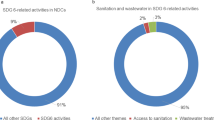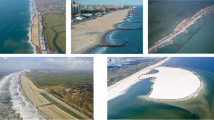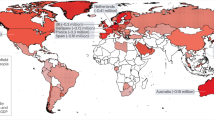Abstract
Sanitation is often viewed as an unmentionable social obligation. Efficiently delivering this public good may involve use of ecosystem services, such as pollutant assimilation in wetlands, yet sanitation need not only consume: recovered resources (nutrients, organic matter and water) may enhance multiple ecosystem services, thereby expanding the value of sanitation. However, potential linkages between sanitation and ecosystem services have received limited attention. Bridging these fields will reveal opportunities to support sustainability goals, particularly in settings with extensive ecological assets but limited economic means. Here we develop a conceptual framework defining pathways through which recoverable resources can enhance ecosystem services and shed light on the viability of exploring synergistic interactions between engineered and natural systems. We find underexplored potential, particularly relating to the contribution resource recovery could make to regional ecosystems in countries across the globe. Such integrative work is needed to advance knowledge of sanitation–ecosystem linkages and stimulate policy efforts to enhance sustainable development and resource cycles.
This is a preview of subscription content, access via your institution
Access options
Access Nature and 54 other Nature Portfolio journals
Get Nature+, our best-value online-access subscription
$29.99 / 30 days
cancel any time
Subscribe to this journal
Receive 12 digital issues and online access to articles
$119.00 per year
only $9.92 per issue
Buy this article
- Purchase on Springer Link
- Instant access to full article PDF
Prices may be subject to local taxes which are calculated during checkout




Similar content being viewed by others
Data availability
All data supporting this study’s findings are available in the Supplementary Information or from the corresponding author upon request.
References
Sustainable Development Goal 6 Synthesis Report 2018 on Water and Sanitation (United Nations, 2018).
Verstraete, W., Van de Caveye, P. & Diamantis, V. Maximum use of resources present in domestic “used water”. Bioresour. Technol. 100, 5537–5545 (2009).
Trimmer, J. T., Cusick, R. D. & Guest, J. S. Amplifying progress toward multiple development goals through resource recovery from sanitation. Environ. Sci. Technol. 51, 10765–10776 (2017).
Millennium Ecosystem Assessment Ecosystems and Human Well-Being: Synthesis (Island, 2005).
Wood, S. L. R. et al. Distilling the role of ecosystem services in the Sustainable Development Goals. Ecosyst. Serv. 29, 70–82 (2018).
Timko, J. et al. A policy nexus approach to forests and the SDGs: tradeoffs and synergies. Curr. Opin. Environ. Sustain. 34, 7–12 (2018).
Biodiversity and the 2030 Agenda for Sustainable Development (Convention on Biological Diversity, 2016).
Wang, X. et al. Evolving wastewater infrastructure paradigm to enhance harmony with nature. Sci. Adv. 4, eaaq0210 (2018).
Gopalakrishnan, V., Grubb, G. F. & Bakshi, B. R. Biosolids management with net-zero CO2 emissions: a techno-ecological synergy design. Clean Technol. Environ. Policy 19, 2099–2111 (2017).
Díaz, S. et al. Assessing nature’s contributions to people. Science 359, 270–272 (2018).
Garcia, X. et al. Placing ecosystem services at the heart of urban water systems management. Sci. Total Environ. 563–564, 1078–1085 (2016).
Rockström, J. et al. A safe operating space for humanity. Nature 461, 472–475 (2009).
Mihelcic, J. R., Fry, L. M. & Shaw, R. Global potential of phosphorus recovery from human urine and feces. Chemosphere 84, 832–839 (2011).
Salzman, J., Bennett, G., Carroll, N., Goldstein, A. & Jenkins, M. The global status and trends of payments for ecosystem services. Nat. Sustain. 1, 136–144 (2018).
Wallace, K. J. Classification of ecosystem services: problems and solutions. Biol. Conserv. 139, 235–246 (2007).
Fisher, B., Turner, R. K. & Morling, P. Defining and classifying ecosystem services for decision making. Ecol. Econ. 68, 643–653 (2009).
Bennett, E. M., Peterson, G. D. & Gordon, L. J. Understanding relationships among multiple ecosystem services. Ecol. Lett. 12, 1394–1404 (2009).
Mehta, C. M., Khunjar, W. O., Nguyen, V., Tait, S. & Batstone, D. J. Technologies to recover nutrients from waste streams: a critical review. Crit. Rev. Environ. Sci. Technol. 45, 385–427 (2015).
Orner, K. D. & Mihelcic, J. R. A review of sanitation technologies to achieve multiple sustainable development goals that promote resource recovery. Environ. Sci. Water Res. Technol. 4, 16–32 (2018).
Etter, B., Tilley, E., Khadka, R. & Udert, K. M. Low-cost struvite production using source-separated urine in Nepal. Water Res. 45, 852–862 (2011).
Tarpeh, W. A., Barazesh, J. M., Cath, T. Y. & Nelson, K. L. Electrochemical stripping to recover nitrogen from source-separated urine. Environ. Sci. Technol. 52, 1453–1460 (2018).
Trimmer, J. T. & Guest, J. S. Recirculation of human-derived nutrients from cities to agriculture across six continents. Nat. Sustain. 1, 427–435 (2018).
Tan, Z. X., Lal, R. & Wiebe, K. D. Global soil nutrient depletion and yield reduction. J. Sustain. Agric. 26, 123–146 (2005).
Lal, R. Soil carbon sequestration impacts on global climate change and food security. Science 304, 1623–1627 (2004).
Cordell, D., Drangert, J.-O. & White, S. The story of phosphorus: global food security and food for thought. Glob. Environ. Change 19, 292–305 (2009).
Fowler, D. et al. The global nitrogen cycle in the twenty-first century. Phil. Trans. R. Soc. B 368, 20130164 (2013).
Smith, V. H., Tilman, G. D. & Nekola, J. C. Eutrophication: impacts of excess nutrient inputs on freshwater, marine, and terrestrial ecosystems. Environ. Pollut. 100, 179–196 (1999).
Logan, B. E. & Rabaey, K. Conversion of wastes into bioelectricity and chemicals by using microbial electrochemical technologies. Science 337, 686–690 (2012).
Sanderman, J., Hengl, T. & Fiske, G. J. Soil carbon debt of 12,000 years of human land use. Proc. Natl Acad. Sci. USA 114, 9575–9580 (2017).
Lal, R. Soil carbon sequestration impacts on global climate change and food security. Science 304, 1623–1627 (2004).
Fry, L. M., Mihelcic, J. R. & Watkins, D. W. Water and nonwater-related challenges of achieving global sanitation coverage. Environ. Sci. Technol. 42, 4298–4304 (2008).
Larsen, T. A., Hoffmann, S., Lüthi, C., Truffer, B. & Maurer, M. Emerging solutions to the water challenges of an urbanizing world. Science 352, 928–933 (2016).
Mueller, N. D. et al. Closing yield gaps through nutrient and water management. Nature 490, 254–257 (2012).
Bayite-Kasule, S. Inorganic Fertilizer in Uganda: Knowledge Gaps, Profitability, Subsidy, and Implications of a National Policy (International Food Policy Research Institute, 2009).
Pitt, J. et al. It takes more than water: restoring the Colorado River Delta. Ecol. Eng. 106, 629–632 (2017).
Zanuzzi, A., Arocena, J. M., van Mourik, J. M. & Faz Cano, A. Amendments with organic and industrial wastes stimulate soil formation in mine tailings as revealed by micromorphology. Geoderma 154, 69–75 (2009).
Lehmann, J. & Kleber, M. The contentious nature of soil organic matter. Nature 528, 60–68 (2015).
Hagen, B., Pijawka, D., Prakash, M. & Sharma, S. Longitudinal analysis of ecosystem services’ socioeconomic benefits: wastewater treatment projects in a desert city. Ecosyst. Serv. 23, 209–217 (2017).
Bischel, H. N. et al. Renewing urban streams with recycled water for streamflow augmentation: hydrologic, water quality, and ecosystem services management. Environ. Eng. Sci. 30, 455–479 (2013).
Dlamini, S. N., Franke, J. & Vounatsou, P. Assessing the relationship between environmental factors and malaria vector breeding sites in Swaziland using multi-scale remotely sensed data. Geospatial Health 10, 302 (2015).
Lu, L. et al. Wastewater treatment for carbon capture and utilization. Nat. Sustain. 1, 750–758 (2018).
Vörösmarty, C. J., Green, P., Salisbury, J. & Lammers, R. B. Global water resources: vulnerability from climate change and population growth. Science 289, 284–288 (2000).
McCarty, P. L., Bae, J. & Kim, J. Domestic wastewater treatment as a net energy producer–Can this be achieved? Environ. Sci. Technol. 45, 7100–7106 (2011).
Godfray, H. C. J. et al. Food Security: the challenge of feeding 9 billion people. Science 327, 812–818 (2010).
Cardinale, B. J. et al. Biodiversity loss and its impact on humanity. Nature 486, 59–67 (2012).
Latham, J., Cumani, R., Rosati, I. & Bloise, M. Global Land Cover SHARE (GLC-SHARE) Database Beta-Release Version 1.0 (2014).
Sato, T., Qadir, M., Yamamoto, S., Endo, T. & Zahoor, A. Global, regional, and country level need for data on wastewater generation, treatment, and use. Agric. Water Manag. 130, 1–13 (2013).
DataBank (World Bank Group, 24 February 2018); http://databank.worldbank.org/data/home.aspx
World Urbanization Prospects: The 2014 Revision (United Nations, Department of Economic and Social Affairs, 2015).
Uddin, S. M. N., Muhandiki, V. S., Fukuda, J., Nakamura, M. & Sakai, A. Ecological sanitation in low income countries: assessment of social acceptance and scope of scaling up. In Proc. 35th WEDC International Conference (ed. Shaw, R. J.) 1–8 (WEDC, 2011).
Hein, L., Miller, D. C. & de Groot, R. Payments for ecosystem services and the financing of global biodiversity conservation. Curr. Opin. Environ. Sustain. 5, 87–93 (2013).
Clark, R., Reed, J. & Sunderland, T. Bridging funding gaps for climate and sustainable development: pitfalls, progress and potential of private finance. Land Use Policy 71, 335–346 (2018).
Degryse, F., Baird, R., da Silva, R. C. & McLaughlin, M. J. Dissolution rate and agronomic effectiveness of struvite fertilizers – effect of soil pH, granulation and base excess. Plant Soil 410, 139–152 (2017).
Ferraro, P. J. & Kiss, A. Direct payments to conserve biodiversity. Science 298, 1718–1719 (2002).
Pagiola, S. Payments for environmental services in Costa Rica. Ecol. Econ. 65, 712–724 (2008).
Jack, B. K., Leimona, B. & Ferraro, P. J. A Revealed preference approach to estimating supply curves for ecosystem services: use of auctions to set payments for soil erosion control in Indonesia. Conserv. Biol. 23, 359–367 (2009).
Proposals for a Comprehensive and Participatory Process for the Preparation of the Post-2020 Global Biodiversity Framework (CBD, 2018).
Benayas, J. M. R., Newton, A. C., Diaz, A. & Bullock, J. M. Enhancement of biodiversity and ecosystem services by ecological restoration: a meta-analysis. Science 325, 1121–1124 (2009).
Starkl, M., Brunner, N., López, E. & Martínez-Ruiz, J. L. A planning-oriented sustainability assessment framework for peri-urban water management in developing countries. Water Res. 47, 7175–7183 (2013).
Daw, T. M. et al. Evaluating taboo trade-offs in ecosystems services and human well-being. Proc. Natl Acad. Sci. USA 112, 6949–6954 (2015).
Gridded Population of the World Version 3 (GPWv3): National Administrative Boundaries (CIESIN, Columbia University, CIAT, 2005).
Gridded Population of the World Version 4 (GPWv4): National Identifier Grid (CIESIN, Columbia University, 2016).
Acknowledgements
The authors would like to acknowledge the Illinois Distinguished Fellowship and Dissertation Completion Fellowship at the University of Illinois at Urbana-Champaign for funding support for J.T.T., as well as support from the Institute for Sustainability, Energy, and Environment (iSEE) at University of Illinois at Urbana-Champaign for D.C.M. and J.S.G.
Author information
Authors and Affiliations
Contributions
J.T.T., D.C.M and J.S.G. conceived of the research. J.T.T. collected data and performed analyses. J.T.T., D.C.M. and J.S.G. interpreted results and wrote the paper.
Corresponding author
Ethics declarations
Competing interests
The authors declare no competing interests.
Additional information
Publisher’s note: Springer Nature remains neutral with regard to jurisdictional claims in published maps and institutional affiliations.
Supplementary information
Supplementary Information
Supplementary Results, Methods, Figs. 1,2, Tables and refs. 1–33.
Supplementary Table 1
Summary of publications at the intersection of sanitation/resource recovery and ecosystem services literature
Supplementary Table 4
Co-location of recoverable resources with dominant land-cover types across 171 countries and territories
Rights and permissions
About this article
Cite this article
Trimmer, J.T., Miller, D.C. & Guest, J.S. Resource recovery from sanitation to enhance ecosystem services. Nat Sustain 2, 681–690 (2019). https://doi.org/10.1038/s41893-019-0313-3
Received:
Accepted:
Published:
Issue Date:
DOI: https://doi.org/10.1038/s41893-019-0313-3
This article is cited by
-
Climate change mitigation potential in sanitation via off-site composting of human waste
Nature Climate Change (2020)



